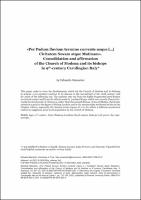Chapter «Per Padum fluvium termino currente usque [...] Civitatem Novam atque Mutinam». Consolidation and affirmation of the Church of Modena and Its bishops in 9th-entury Carolingian Italy
| dc.contributor.author | Manarini, Edoardo | |
| dc.date.accessioned | 2022-12-22T16:06:33Z | |
| dc.date.available | 2022-12-22T16:06:33Z | |
| dc.date.issued | 2022 | |
| dc.identifier | ONIX_20221222_9788855186230_47 | |
| dc.identifier.issn | 2704-6079 | |
| dc.identifier.uri | https://library.oapen.org/handle/20.500.12657/60385 | |
| dc.description.abstract | This paper seeks to trace the developments which led the Church of Modena and its bishops to acquire a pre-eminent position in its diocese in the second half of the ninth century and for much of the following one. The analysis sets out from the highly fragmented post-Roman territorial context and from the efforts made by Lombard kings, which were mostly directed towards the fiscal estate of Cittanova, rather than the ancient Roman civitas of Mutina. Particular attention is paid to the figure of Bishop Leodoin and to the manuscripts attributed to him in the Chapter Library, especially the famous Codex legum (O.I.2), for which a different production context is suggested, prior to its acquisition by the Church of Modena. | |
| dc.language | English | |
| dc.relation.ispartofseries | Reti Medievali E-Book | |
| dc.subject.classification | thema EDItEUR::N History and Archaeology::NH History | en_US |
| dc.subject.other | Middle Ages | |
| dc.subject.other | 9th century | |
| dc.subject.other | Italy | |
| dc.subject.other | Modena | |
| dc.subject.other | Leodoin | |
| dc.subject.other | fiscal estates | |
| dc.subject.other | bishops’ soft power | |
| dc.subject.other | lay manuscripts | |
| dc.title | Chapter «Per Padum fluvium termino currente usque [...] Civitatem Novam atque Mutinam». Consolidation and affirmation of the Church of Modena and Its bishops in 9th-entury Carolingian Italy | |
| dc.type | chapter | |
| oapen.identifier.doi | 10.36253/978-88-5518-623-0.08 | |
| oapen.relation.isPublishedBy | bf65d21a-78e5-4ba2-983a-dbfa90962870 | |
| oapen.relation.isbn | 9788855186230 | |
| oapen.series.number | 41 | |
| oapen.pages | 25 | |
| oapen.place.publication | Florence |

